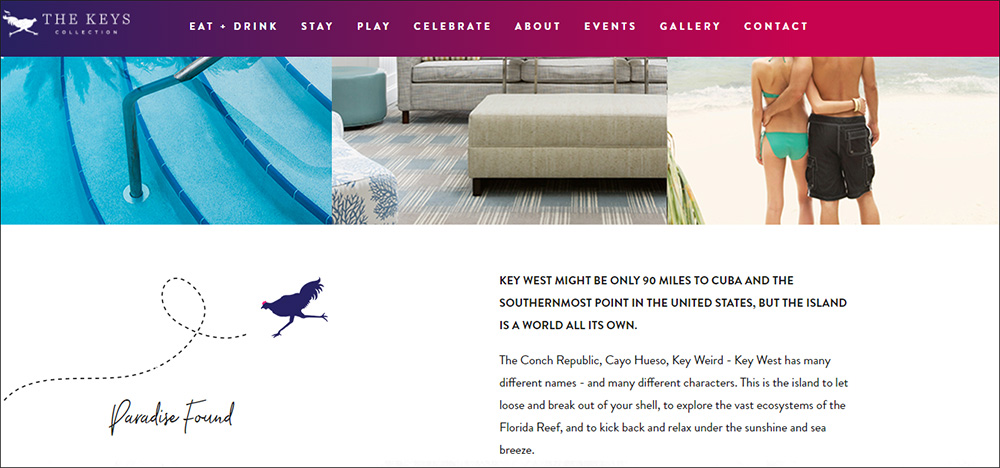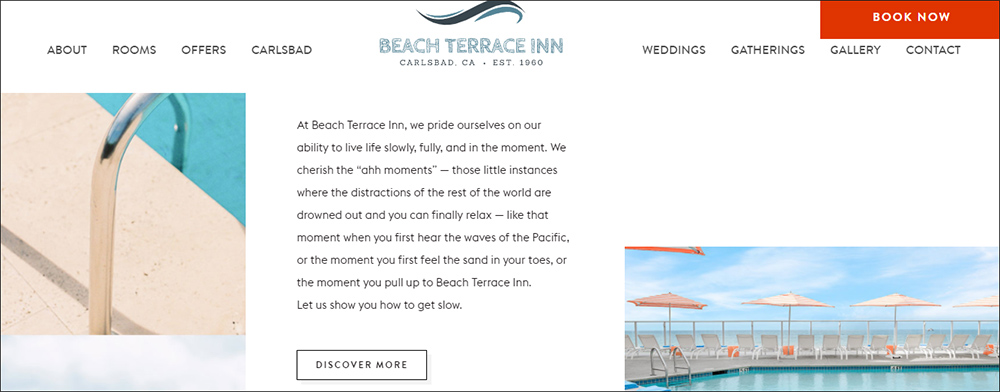
By Kate Bielamowicz
The power of great hotel copywriting on your website can’t be overstated. Far more than filling space on a page, the right words can spark the imagination of your potential guests, and move them one step closer to booking.
Persuasive copywriting can fire up your conversion rates by using the kind of language that differentiates you from the competition, and connects your brand with your audience.
While there are countless ways to upgrade the copy on your hotel website, the following three tips (with examples) are relatively easy to apply and can have a major impact.
Focus on the needs of your guests
The attention span of the typical online travel shopper is fleeting. So when they land on your homepage, your copy needs to instantly connect with them. To achieve this, a lot of hotel websites attempt to say everything in order to appeal to everyone. But it’s an approach rarely works.
The majority of your audience won’t be engaged by an exhaustive list of your top ten features. But they will be engaged if you focus on the amenities and attractions that they are most interested in.
At Cupertino Hotel in Silicon Valley, their website primarily targets business travelers, and it focuses on what the majority of this audience care about most: location and convenience.
The first section of copy on their homepage gives specific distances from the hotel to nearby airports and transport links.
There’s nothing fancy going on here, but this kind of simple information is exactly what a lot of business travelers will be interested in. Only further down the homepage does the copy then mention the hotel’s suites and services.
This is a perfect example of how the copy on your homepage should be built around the most relevant needs and desires of your target audience.
What does your own typical guest care about most? If this answer isn’t obvious, there are plenty of ways to find out. Check out your TripAdvisor reviews. Send out short post-stay surveys via email. Or simply ask your guests what they enjoyed most about their stay during check out.
Look for patterns. If a lot of your guests mention your chilled oceanside setting, your family-friendly facilities, or your funky rooftop bar, make these features the heart and soul of your copy.
Once you’ve grabbed the attention of your audience, you can use the rest of your website to list other attractive qualities to further reel them in.
Mastering your tone of voice
After deciding what to say, you need to work out how to say it. This is all about the art of crafting your tone of voice—an area that often gets rushed or completely overlooked.
However, the words you use on your website have real power. They can create a specific mood, conjure up vivid mental imagery, and completely change how your property is perceived.
Again, the key to success here is knowing your audience. A funky urban property targeting twenty-something backpackers might adopt a casual and punchy tone. Clearly that wouldn’t be right for a luxury boutique targeting an over-50s demographic.
At The Keys Collection hotels, most of their guests are looking for a chilled beachside getaway, so the copy reflects this. Their tone is laid-back and breezy. It uses sensory-rich language, built around a theme of escapism.
Phrases such as “let loose and break out of your shell” and “kick back and relax” are designed to speak to the beach-seeking vacationer. Based on the mindset of this hotel’s typical guest, this kind of light, casual phrasing is perfect.
In contrast, Moxy Hotels use a fun, playful tone to connect with its Millennial audience.
The homepage of their Times Square hotel describes the property as a “launch pad” and “your ultimate playground,” while their rooftop bar is described as “the biggest and baddest in NYC.”
As a general rule, it’s worth taking the time to create a distinctive tone of voice. Opting for a generic tone aimed at pleasing all can make you come off sounding bland, and it definitely won’t help you stand out from your competitors.
Focus on benefits, not features
When writing your copy, it’s important to consider a golden rule: your guests are interested in benefits, not features. So while it might be tempting to describe all the great things about your hotel (features), people only care how these will enhance their experience.
Remember, consumer purchases are always driven by one question: “What’s in this for me?” And these purchases are often rooted in emotion. In fact, studies have shown that consumer decision-making is driven more by emotions than information.
So when you tell guests about benefits instead of features, you’re more likely to boost these emotionally-driven choices.
To help with this process, consider how your hotel’s standout features relate to an emotion or experience. At the Beach Terrace Inn in Carlsbad, they describe their exotic location in a way that invites the guest into the scene.
The example above uses a type of sensory-rich language designed to create specific scenes and moods:
“We cherish the “ahhh moments — those little instances where the distractions of the rest of the world are drowned out and you can finally relax — like that moment when you first hear the waves of the Pacific, or the moment you first feel the sand in your toes …”
The choice of language here subtly shifts the emphasis towards the guest. Rather than simply describing the location, it places the reader at the heart of the scene.
If you want to turn features into benefits, simply think about things from your guest’s perspective. To further illustrate this point, the following example shows how a feature can be translated into a benefit:
Feature: Our family-friendly hotel has a huge kids’ water park. Benefit: Busy parents can unwind and put their feet up while their kids have a great time in the pool.
When the feature is turned into a benefit, the copy could be written like this:
“Kick back with an ice-cold drink from a poolside lounger while the kids splash around in our giant water park. Ear-to-ear grins all around … guaranteed!”
You don’t want to overdo these kind of descriptions, but used sparingly, they can have real impact. Especially on your homepage.
Obviously, there are parts of your website where listing features is more appropriate, such as your Rooms page. At this point, you can assume users are interested in your property and moving closer to making a booking with you.
Great copywriting drives conversions
Great hotel copywriting helps you connect with your guests by tapping into their needs and preferences. It has the power to spark their imagination, distinguish you from the competition, and ultimately—drive bookings.
Before writing a word, it’s essential to know who your audience is, and what kind of experience they’re looking for. Based on this, you can focus your messaging on their needs and desires to really capture their interest.
Creating a tone of voice based on your target audience will help you connect with them more effectively, using a style of language that truly resonates with them. Finally, think about how your best features can be described in terms of guest-orientated benefits.
By applying these three tactics, your hotel website will be far more likely to inspire and engage your target audience, increasing your direct bookings as a result.






